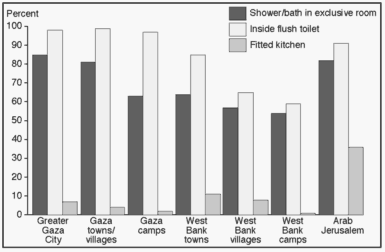
|
|||||||||||||||||||||||||||||||||||||||||||||||||||||||||||||||||||||||||||||||||||||||||||||||||||
Indoor StandardsIndoor standards are partly dependent on the facilities the house contains as well as its furnishings. Needless to say, the quality and quantity of both are indicators of the household's economic resources. Nonetheless, household facilities indicate the degree of comfort and convenience a house affords its occupants. Among the key facilities are a separated bathroom, an inside flush toilet, a fitted kitchen, and sufficient heating to provide warmth and a shield against damp during the winter season. The insulating qualities of the building materials utilised also, of course, have an impact on the provision of warmth.With regard to heating, in Arab Jerusalem 56% of households depend on kerosine heaters and 20% have electrical bars as the main source for heat. In the towns of the West Bank kerosine heaters, wood/charcoal burning stoves and braziers are the main forms. In the villages and camps of the West Bank wood burning stoves are predominant, as they are throughout Gaza. Some 20% of the households in Gaza report that they have no form of heating whatsoever. Although Gaza does not experience the same cold winters as the West Bank, winters can nonetheless be both chilly and very damp.
Figure 3.4 Percentage of households with internal facilities by locality Again an index of household facilities has been constructed to measure the relative combined distribution of these amenities among the Palestinian population. Once more (figure 3.5) it is in the rural areas and camps of the West Bank, rather than in Gaza as might have been expected, that internal housing standards are the least satisfactory.
Figure 3.5 Internal comfort index by type of locality9 Household furnishings and equipment tend to reflect the socio-economic standing of the household as well as gender relations within it. They also provide a certain measure of changing social values. Traditionally in Palestine, as throughout large parts of the Middle East, the status of families was more often expressed by the spaciousness of the salon than by the lavishness of kitchens or sleeping quarters.10 The salon was where the men of the household received and entertained guests and relatives. Status was reflected by the generosity of hospitality, the comfort provided by the divans and chairs placed along the walls of the room and the size and luxuries of the room itself. Although these patterns have to some extent been modified by social and economic changes, the kitchen remains the domain principally of women. In a society where women are largely confined to the house, have responsibility for most domestic tasks and have access to money only through the forbearance of men, women's labour is cheap. Thus, investment in parts of the house defined as the woman's realm makes little economic sense and solicits little social esteem.11 Moreover, the values which underlie the consumption preferences of men are mostly shared by women. They tend to favour directing investment toward the most socially prominent areas of the house. Historically, the groom's family was obliged to furnish the house to be used by the bridal couple. The furnishings provided were detailed in the wedding contract. For peasants this was usually limited to long, flat cotton mattresses and storage chests. Today, for couples moving in with the groom's family, still common in the camps, villages and in poorer urban areas, the groom's obligation is confined to furnishing the bedroom of the couple. In high density households the bedroom is the only room that provides any degree of privacy for couples living in extended households. Among middle class Palestinians furniture is usually needed for a whole house and consequently constitutes a notable additional cost to getting married. Westernisation of tastes started in the Mandate period and is now almost complete among the urban and rural middle classes. The first shift, reflecting increased prosperity, focused on bedrooms, the second on fitted kitchens. Westernisation of tastes has begun penetrating the poorer sectors of the population in the form of elaborate bedroom furniture acquired upon marriage. However, few poor households have rooms which are mainly reserved for a single activity. Instead, rooms are multi-purpose. Among the poor, the same space serves for socialising, children's games, food preparation and sleeping quarters for unmarried household members.
Table 3.9 Percentage of households that own:12
The list of selected household possessions in table 3.9 mirrors to some
extent the relative economic resources of households as well as trends toward
the westernisation of consumption patterns. A critical aspect of the table
(3.9) is that it lists not only the percentage of households that own a
given item, but also the percentage which purchased that item new rather
than used. New items are frequently 4 to 5 times more expensive than used
ones. Thus, comparison of items owned and purchased new gives both an economic
indication of consumer preferences and an indication of the quality of possessions.
Notably, for instance, neither colour televisions nor fridges are cutting
edge commodities indicating that the owner belongs to a more elevated economic
strata. However, if a household owns a colour television, a prestige item
nonetheless, it is much more likely to have been purchased new than a fridge,
an item most Palestinians own, but an item connected to the kitchen.
|
|||||||||||||||||||||||||||||||||||||||||||||||||||||||||||||||||||||||||||||||||||||||||||||||||||
 al@mashriq 960715 | |||||||||||||||||||||||||||||||||||||||||||||||||||||||||||||||||||||||||||||||||||||||||||||||||||

